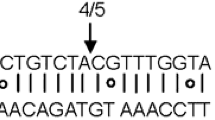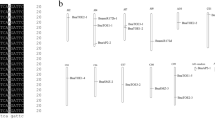Key Message
MIR159/319 have conserved evolution and diversified function after WGT in Brassica campestris, both of them can lead pollen vitality and germination abnormality, Bra-MIR319c also can function in flower development.
Abstract
MiR159 and miR319 are extensively studied highly conserved microRNAs which play roles in vegetative development, reproduction, and hormone regulation. In this study, the effects of whole-genome triplication (WGT) on the evolution of the MIR159/319 family and the functional diversification of the genes were comprehensively investigated in Brassica campestris. We identified 11 MIR159/319 genes in B. campestris, which produced five mature sequences. After analyzing the precursor sequences and phylogenetic tree, we found that Bra-MIR159/319 have evolutionary conservatism. Furthermore, Bra-MIR159/319 show functional diversification after WGT, as indicated by their expression patterns and the cis-element in their promoter. GUS signal showed that Bra-MIR159a and Bra-MIR319c can be expressed in anther but in different development stages. In B. campestris, overexpressed MIR159a and MIR319c contribute to late anther development and promote pollen abortion. Moreover, Bra-MIR319c can partially assume the function of MIR319a in flower development.










Similar content being viewed by others
References
Achard P, Herr A, Baulcombe D, Harberd N (2004) Modulation of floral development by a gibberellin-regulated microRNA. Development 131:3357–3365
Allen E, Xie Z, Gustafson A, Sung G, Spatafora J, Carrington J (2004) Evolution of microRNA genes by inverted duplication of target gene sequences in Arabidopsis thaliana. Nat Genet 36:1282–1290
Allen R, Li J, Stahle M, Dubroue A, Gubler F, Millar A (2007) Genetic analysis reveals functional redundancy and the major target genes of the Arabidopsis miR159 family. Proc Natl Acad Sci USA 104:16371–16376
Allen R, Li J, Alonso-Peral M, White R, Gubler F, Millar A (2010) MicroR159 regulation of most conserved targets in Arabidopsis has negligible phenotypic effects. Silence 1:18
Axtell M, Bartel D (2005) Antiquity of microRNAs and their targets in land plants. Plant Cell 17:1658–1673
Barik S, SarkarDas S, Singh A, Gautam V, Kumar P, Majee M, Sarkar A (2014) Phylogenetic analysis reveals conservation and diversification of microRNA166 genes among diverse plant species. Genomics 103:114–121
Bologna N, Mateos J, Bresso E, Palatnik J (2009) A loop-to-base processing mechanism underlies the biogenesis of plant microRNAs miR319 and miR159. EMBO J 28:3646–3656
Borges F, Pereira PA, Slotkin RK, Martienssen RA, Becker JD (2011) MicroRNA activity in the Arabidopsis male germline. J Exp Bot 62:1611–1620
Bowers J, Chapman B, Rong J, Paterson A (2003) Unravelling angiosperm genome evolution by phylogenetic analysis of chromosomal duplication events. Nature 422:433
Cavell AC, Lydiate DJ, Parkin IAP, Dean C, Tric M (1998) Collinearity between a 30-centimorgan segment of Arabidopsis thaliana chromosome 4 and duplicated regions within the Brassica napus genome. Genome 41:62–69
Chandan R, Indra D (2014) Gene duplication: a major force in evolution and bio-diversity. Int J Biodivers Conserv 6:41–49
Cheng F, Wu J, Fang L, Sun S, Liu B, Lin K, Bonnema G, Wang X (2012) Biased gene fractionation and dominant gene expression among the subgenomes of Brassica rapa. PLoS ONE 7:e36442
Drakakaki G, Zabotina O, Delgado I, Robert S, Keegstra K, Raikhel N (2006) Arabidopsis reversibly glycosylated polypeptides 1 and 2 are essential for pollen development. Plant Physiol 142(4):1480–1492
Freeling M (2009) Bias in plant gene content following different sorts of duplication: tandem, whole-genome, segmental, or by transposition. Annu Rev Plant Biol 60:433–453
He X, Zhang J (2005) Gene complexity and gene duplicability. Curr Biol 15:1016–1021
Huang L, Cao J, Ye W, Liu T, Ye Y (2008) Transcriptional differences between the male sterile mutant bcms and wild type of Brassica campestris ssp. chinensis reveal genes related to pollen development. Plant Biol 10:342–355
Jefferson R, Kavanagh T, Bevan M (1987) GUS fusions: b-glucuronidase as a sensitive and versatile gene fusion marker in higher plants. EMBO J 6:3901–3907
Jiang JX, Lv ML, Liang Y, Ma ZM, Cao JS (2014) Identification of novel and conserved miRNAs involved in pollen development in Brassica canpestris ssp. chinensis by high-throughput sequencing and degradome analysis. BMC Genomics 15:146–158
Jones-Rhoades M, Bartel D (2004) Computational identification of plant MicroRNAs and their targets, including a stress-induced miRNA. Mol Cell 14:787–799
Jones-Rhoades M, Bartel D, Bartel B (2006) MicroRNAs and their regulatory roles in plants. Annu Rev Plant Biol 57:19–53
Kowalski SP, Lan TH, Feldmann KA, Paterson AH (1994) Comparative mapping of Arabidopsis thaliana and Brassica oleracea chromosomes reveal islands of conserved organization. Genetics 138:499–510
Koyama T, Sato F, Ohme-Takagi M (2017) Roles of miR319 and TCP transcription factors in leaf development. Plant Physiol 175:874–885
Lagercrantz U (1998) Comparative mapping between Arabidopsis thaliana and Brassica nigra indicates that Brassica genomes have evolved through extensive genome replication accompanied by chromosome fusions and frequent rearrangements. Genetics 150:1217–1228
Li Y, Li W, Jin Y (2005) Computational identification of novel family members of MicroRNA genes in Arabidopsis thaliana and Oryza sativa. Acta Biochim Biophys Sin 37:75–87
Li Y, Li C, Ding G, Jin Y (2011) Evolution of MIR159/319 microRNA genes and their post-transcriptional regulatory link to siRNA pathways. BMC Evol Biol 11:122
Li J, Wang YZ, Zhang YX, Wang WY, Irish VF, Huang TB (2016) RABBIT EARS regulates the transcription of TCP4 during petal development in Arabidopsis. J Exp Bot 67:6473–6480
Liang Y, Tan ZM, Zhu L, Niu QK, Zhou JJ, Li M, Chen LQ, Zhang XQ, Ye D (2013) MYB97, MYB101 and MYB120 function as male factors that control pollen tube-synergid interaction in Arabidopsis thaliana fertilization. PLoS Genet 9:e1003933
Lin S, Dong H, Zhang F, Qiu L, Wang F, Cao J, Huang L (2014) BcMF8, a putative arabinogalactan protein-encoding gene, contributes to pollen wall development, aperture formation and pollen tube growth in Brassica campestris. Annu Bot 10:1093
Lin S, Yue X, Miao Y, Yu Y, Dong H, Huang L, Cao J (2018) The distinct functions of two classical arabinogalactan proteins BcMF8 and BcMF18 during pollen wall development in Brassica campestris. Plant J 94:60–76
Liu S, Liu Y, Yang X, Tong C, Edwards D, Parkin I, Zhao M, Ma J, Yu J, Huang S (2014) The Brassica oleracea genome reveals the asymmetrical evolution of polyploid genomes. Nat Commun 5:3930
Livak K, Schmittgen T (2001) Analysis of relative gene expression data using real-time quantitative PCR and the 2−∆∆CT method. Methods 25:402–408
Lyu M, Yu Y, Jiang J, Song L, Liang Y, Ma Z et al (2015) BcMF26a and BcMF26b are duplicated polygalacturonase genes with divergent expression patterns and functions in pollen development and pollen tube formation in Brassica campestris. PLoS ONE 10:e0131173
Maher C, Stein L, Ware D (2006) Evolution of Arabidopsis microRNA families through duplication events. Genome Res 16:510–519
Millar A, Gubler F (2005) The Arabidopsis GAMYB-like genes, MYB33 and MYB65, are microRNA-regulated genes that redundantly facilitate anther development. Plant Cell 17:705–721
Nag A, King S, Jack T (2009) miR319a targeting of TCP4 is critical for petal growth and development in Arabidopsis. PNAS 106:22534–22539
Palatnik J, Allen E, Wu X, Schommer C, Schwab R, Carrington J, Weigel D (2003) Control of leaf morphogenesis by microRNAs. Nature 425:257–263
Palatnik J, Wollmann H, Schommer C, Schwab R, Boisbouvier J, Rodriguez R, Warthmann N, Allen E, Dezulian T, Huson D, Carrington J, Weigel D (2007) Sequence and expression differences underlie functional specialization of arabidopsis microRNAs miR159 and miR319. Dev Cell 13:115–125
Roulin A, Auer P, Libault M, Schlueter J, Farmer A, May G, Stacey G, Doerge R, Jackson S (2013) The fate of duplicated genes in a polyploid plant genome. Plant J 73:143–153
Ryder CD, Teakle GR, King GJ (2001) Contrasting genome organisation: two regions of the Brassica oleracea genome compared with collinear regions of the Arabidopsis thaliana genome. Genome 44:808–817
Sanders PM, Bui AQ, Weterings K, McIntire KN, Hsu Y-C, Lee PY, Truong MT, Beals TP, Goldberg RB (1999) Anther developmental defects in Arabidopsis thaliana male-sterile mutants. Sex Plant Reprod 11:297–322
Sun C, Wu J, Liang J, Schnable J, Yang W, Cheng F, Wang X (2015) Impacts of whole-genome triplication on MIRNA evolution in Brassica rapa. Genome Biol Evol 7:3085–3096
Wang X, Wang H, Wang J, Sun R, Wu J, Liu S, Bai Y, Mun J-H, Bancroft I, Cheng F (2011) The genome of the mesopolyploid crop species Brassica rapa. Nat Genet 43:1035–1039
Warthmann N, Das S, Lanz C, Weigel D (2008) Comparative analysis of the MIR319a MicroRNA locus in arabidopsis and related Brassicaceae. Mol Biol Evol 25:892–902
Yeung EC, Oinam GS, Yeung SS, Harry I (2011) Anther, pollen and tapetum development in safflower, Carthamus tinctorius L. Sex Plant Reprod 24(4):307–317
Yu X, Cao J, Ye W, Wang Y (2004) Construction of an antisense CYP86MF gene plasmid vector and production of a male-sterile Chinese cabbage transformant by the pollen-tube method. J Horticult Sci 79:833–839
Zhang B, Pan X, Cannon C, Cobb G, Anderson A (2006) Conservation and divergence of plant microRNA genes. Plant J 46:243–259
Zhao Y, Wang S, Wu W, Li L, Jiang T, Zheng B (2018) Clearance of maternal barriers by paternal miR159 to initiate endosperm nuclear division in Arabidopsis. Nat Commun 9:5011
Acknowledgements
This work was supported by the National Natural Science Foundation of China (No. 31772311).
Author information
Authors and Affiliations
Contributions
Ziwei Hu designed all the experiments. Xiuping She and Xun Xiang took part in this work and the manuscript modification. Jiaoshu Cao is the corresponding author.
Corresponding author
Additional information
Publisher's Note
Springer Nature remains neutral with regard to jurisdictional claims in published maps and institutional affiliations.
Electronic supplementary material
Below is the link to the electronic supplementary material.
Rights and permissions
About this article
Cite this article
Hu, Z., Shen, X., Xiang, X. et al. Evolution of MIR159/319 genes in Brassica campestris and their function in pollen development. Plant Mol Biol 101, 537–550 (2019). https://doi.org/10.1007/s11103-019-00920-z
Received:
Accepted:
Published:
Issue Date:
DOI: https://doi.org/10.1007/s11103-019-00920-z




